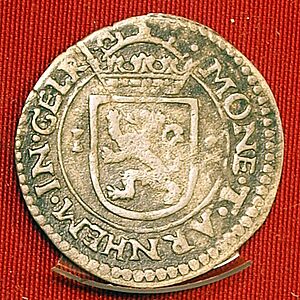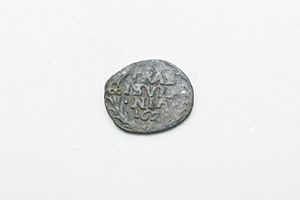Stuiver facts for kids
| Value | 0.05 Dutch guilder |
|---|---|
| Mass | 3.5 g |
| Diameter | 21 mm |
| Thickness | 1.45 mm |
| Edge | plain |
| Orientation | coin |
| Composition | 95% Cu, 4% Sn, 1% Zn |
| Years of minting | 1948–2001 (Utrecht) |
| Circulation | 1948– 28 January 2002 Redeemed by national bank until 1 January 2007 |
| Catalog number | - |
| Obverse | |
 |
|
| Design | Queen Wilhelmina (1948) Queen Juliana (1950–1980) Queen Beatrix (1982–2001) |
| Designer | L. O. Wenckebach (1948–1980) Bruno Ninaber van Eyben (1982–2001) |
| Reverse | |
 |
|
| Design | Face value, year, privy mark (left), mint mark (right) |
| Designer | L. O. Wenckebach (1948–1980) Bruno Ninaber van Eyben (1982–2001) |
The stuiver was an old coin from the Netherlands. It was worth 1⁄20 of a Dutch Guilder. This means 20 stuivers made one guilder! It was also used in some Dutch colonies around the world.
Even today, the word "stuiver" can refer to the 5 euro cent coin. This is because the 5 euro cent coin looks very similar in size and color to the old stuiver, even though it's worth more.
Stuiver in the Netherlands

The stuiver coin first appeared around 1434. It was created by Philip III of Burgundy to be a common coin for several regions, including Brabant, Flanders, Holland, and Hainault.
The name "stuiver" comes from the Dutch word stuiven, which means "flying sparks." This is because early stuiver coins from Flanders showed sparks coming from the Collar of the Golden Fleece.
Before the Netherlands changed its money system, 20 stuivers were equal to one Dutch Guilder. The stuiver was used until the Napoleonic Wars in the early 1800s.
In 1818, the Netherlands changed its money to a decimal system. This meant one guilder was now equal to 100 cents. After this, the stuiver became a nickname for the five-cent coin. People kept using this nickname until the euro currency was introduced in 2002.
Stuiver in Other Countries
The stuiver wasn't just used in the Netherlands. It also traveled to other parts of the world because of Dutch trade and colonies.
From 1660, the Dutch East India Company (VOC) made copper stuiver coins for use in Dutch Ceylon (which is now Sri Lanka). At first, these coins just had their value stamped on them. Later, they added the VOC company logo and the year. These coins were made in different cities in Ceylon until the British took over in 1796.
The stuiver was also a currency in places like Sri Lanka and the Caribbean islands during the 18th and 19th centuries. It was used in Dutch, Danish, and Swedish colonies. It was also part of the money system in Demerara-Essequibo, which is now Guyana.
In British colonies, a stuiver was worth two pence. The coin was even mentioned in the famous poem "The Pied Piper of Hamelin" by Robert Browning. In the poem, the Piper says, "With you, don't think I'll bate [reduce my demands by] a stiver!" This shows how well-known the coin was.
Images for kids
-
A 1⁄4 Stüber coin from Hanover for East Frisia, 1823.
See also
- 5 Cent WWII (Dutch coin)
- 5 Cent 1948 (Dutch coin)





